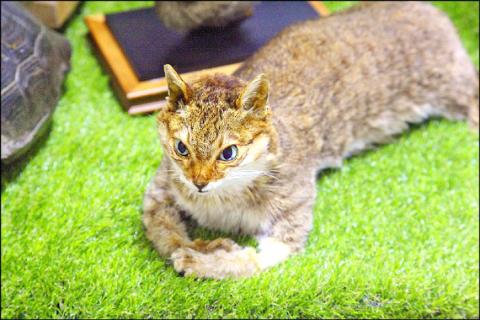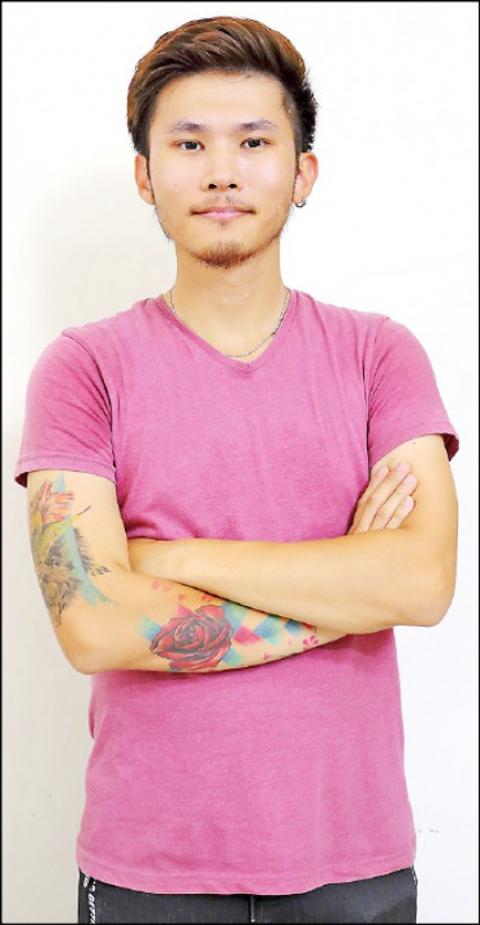Many people treat their pets like a member of the family. When a beloved family pet passes away, some owners choose to have them stuffed and preserved by a taxidermist; however many people know little of the art of taxidermy. A skilled taxidermist is able to retain the animal’s appearance just as it was before it died and capture a realistic pose so that it can stay by its owner’s side even after death.
Taxidermist Kuo Wei-hung says “We respect both the feelings of the pet and its owner. According to the owner’s wishes, we may retain the animal’s skeleton and organs, but whatever we do we are always respectful toward the animal.”
Although Kuo would watch his father, a taxidermist, preserve animals and aquired some basic knowledge through osmosis, Kuo’s original desire was to work in the food and beverage industry. However, as his father’s health began to deteriorate, Kuo would lend a hand and came into contact with his father’s clients.

Photo: Lee Hui-chou, Liberty Times
照片:自由時報記者李惠洲
Kuo began to understand the heartfelt wish of the pet owners to preserve their loved one after death, and was extremely moved by the affection owners displayed for their fury friends. Kuo also wanted to carry on the family business and these twin feelings motivated him to enter the world of taxidermy.
Kuo began by studying the physical composition, unique characteristics and habits of each species of pet animal. This meant that when discussing preservation methods with clients, Kuo could fully understand a pet’s unique qualities and also predict what challenges he might encounter during the process.
On receiving a new specimen, Kuo first cleans internal organs and feces from inside the body. He then asks the owner whether they wish to preserve their pet or opt for cremation. If the client wishes to preserve the animal, Kuo will then carry out a second stage of cleaning and ask what type of posture they would like their pet to adopt before starting the modeling process. All of this work has to be carried out in a cool environment at room temperature.

Photo: Lee Hui-chou, Liberty Times
照片:自由時報記者李惠洲
The next step involves allowing the body to dry out, which is either done by air-drying or through freezing. While this is happening Kuo must pay attention to any areas of the body that may begin to sag, and will stuff these areas with cotton wool as necessary. Once the animal is thoroughly dried out, Kuo uses modeling clay to fill in any contours and lines around the eyes, and will also cover any scarring to the skin.
(Translated by Edward Jones, Taipei Times)
許多人把毛孩當成家人般對待,因此毛孩過世時,有些飼主會將牠製成標本,不過很多人對動物標本師很陌生,然而透過他的手,可以讓寵物保留生前的姿態,定格住完美的身影,永遠陪在飼主身邊。動物標本師郭偉宏說:「我們會尊重寵物和飼主的感受,依據飼主需求,盡可能保留骨骼跟內臟,以我們認為最尊重牠們的方式製作。」

Photo: Lee Hui-chou, Liberty Times
照片:自由時報記者李惠洲
雖然從小跟在父親身邊,看著父親製作一件件動物標本,耳濡目染之下也有些了解,但其實他最初的夢想是從事餐飲業。只是當時的他因父親身體不適需幫忙製作標本,才接觸到許多客人,在與客人溝通時,他明確了解到飼主是真心想把過世的寵物留下來,被飼主與毛孩之間的情誼打動,同時也想繼承家業,於是郭偉宏正式踏入這個行業。
在初期郭偉宏開始研究每個種動物的身體構造、特色與習性,因為當客人聯繫時,就須知道寵物有哪些特色、製作時會遇到哪些問題,與飼主溝通製作方式。在標本送來時,他會初步清理身體裡的內臟與排泄物,再看飼主是要防腐,或若不留下就火化,之後會再做一次清洗,接著以飼主希望的型態開始塑形,這些都是在常溫下完成。
下一步則是要等待乾燥(視情況風乾或冷凍),等待同時要注意哪些部位會萎縮,若有則適時填充一些棉花,等待乾燥完後就會收尾,像是以模型土修飾眼睛周圍的輪廓紋路等,皮膚上如有傷疤也要一起補好。
(自由時報記者姜凱玲)

In an effort to fight phone scams, British mobile phone company O2 has introduced Daisy, an AI designed to engage phone con artists in time-wasting conversations. Daisy is portrayed as a kindly British granny, exploiting scammers’ tendency to target the elderly. Her voice, based on a real grandmother’s for authenticity, adds to her credibility in the role. “O2” has distributed several dedicated phone numbers online to direct scammers to Daisy instead of actual customers. When Daisy receives a call, she translates the scammers’ spoken words into text and then responds to them accordingly through a text-to-speech system. Remarkably, Daisy

Bilingual Story is a fictionalized account. 雙語故事部分內容純屬虛構。 Emma had reviewed 41 resumes that morning. While the ATS screened out 288 unqualified, she screened for AI slop. She could spot it a mile away. She muttered AI buzzwords like curses under her breath. “Team player.” “Results-driven.” “Stakeholder alignment.” “Leveraging core competencies.” Each resume reeked of AI modeling: a cemetery of cliches, tombstones of personality. AI wasn’t just changing hiring. It was draining the humanity from it. Then she found it: a plain PDF cover letter. No template. No design flourishes. The first line read: “I once tried to automate my

Every May 1, Hawaii comes alive with Lei Day, a festival celebrating the rich culture and spirit of the islands. Initiated in 1927 by the poet Don Blanding, Lei Day began as a tribute to the Hawaiian custom of making and wearing leis. The idea was quickly adopted and officially recognized as a holiday in 1929, and leis have since become a symbol of local pride and cultural preservation. In Hawaiian culture, leis are more than decorative garlands made from flowers, shells or feathers. For Hawaiians, giving a lei is as natural as saying “aloha.” It shows love and

1. 他走出門,左右看一下,就過了馬路。 ˇ He walked outside, looked left and right, and crossed the road. χ He walked outside and looked left and right, crossed the road. 註︰並列連接詞 and 在這句中連接三個述語。一般的結構是 x, y, and z。x and y and z 是加強語氣的結構,x and y, z 則不可以。 2. 他們知道自己的弱點以及如何趕上其他競爭者。 ˇ They saw where their weak points lay and how they could catch up with the other competitors. χ They saw where their weak points lay and how to catch up with the other competitors. 註:and 一般連接同等成分,結構相等的單詞、片語或子句。誤句中 and 的前面是子句,後面是不定詞片語,不能用 and 連接,必須把不定詞片語改為子句,and 前後的結構才相等。 3. 她坐上計程車,直接到機場。 ˇ She took a cab, which took her straight to the airport. ˇ She took a cab and it took her straight